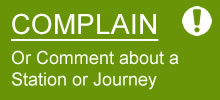By Dennis Fancett, Chair, SENRUG May 2016
The decision to travel the length of the USA West Coast by train came about almost by accident. The original intention had been to travel from east to west across the continent, but the wish to visit relatives in San Francisco, and insufficient time to do both, resulted in the north – south journey instead.
It’s easy enough to find out the train schedules on the AMTRAK website and indeed you can book online, but we wanted some further information such as whether reserved seats would be upstairs or downstairs and if they could be requested for the west side of the train (for coastal views). Any online enquiry on Amtrak’s website failed to answer the question but produced a response telling you to phone their toll free number – which of course is not free from the UK, making the online enquiry service itself rather pointless.
Plenty of UK travel agents can book Amtrak journeys but in the end we found Holidays By Rail (0800 033 7960) who really seemed to know the Amtrak business, were able to answer our questions and did not surcharge for booking the tickets, charging us exactly the same price in dollars as advertised on Amtrak’s website.
My long suffering wife did not want to spend more than one night on the train and in any case, if the reason for the journey is to admire the views, night time travel is pointless. For the northern section however there is no choice as only 1 train a day runs. Given we also wanted to break the journey in San Francisco, our final itinerary was follows:
First, Seattle to Emeryville (for San Francisco) on the Coast Starlight. This is a near 24-hour journey from 09:35 in the morning to 08:10 the next day. For this, we chose a superliner room which comes with its own wc and shower, all be it very compact. A room takes up the whole width of the carriage (except side corridor) and you sleep at right angles to the direction of travel. Ideal for 2, a room can actually take 3 and would be ideal if travelling with a child. The spacious seats convert into upper and lower bunks, and heavy duty straps prevent the upper bunk passenger from rolling off!
Then Emeryville to Santa Barbara again on the Coast Starlight but from 08:20 in the morning to 17:55 the same evening. For this, we choose a superliner roomette, sleeping accommodation but without the private facilities. It may seem strange to have chosen sleeper accommodation for a daytime journey, but the two types of sleeper accommodation count as first class, both giving free meals on the train and other benefits, and this lower category of sleeper was only marginally more expensive than a business class seat for this leg.
Finally, Santa Barbara to San Diego on the Pacific Surfliner, a daytime journey from 14:04 to 20:07. This is not a sleeper train and offers just business or coach class with us choosing the former. Business class seats on the Surfliner are not reserved though in coach class, a seat is not even guaranteed! But even though Amtrak say seats can not be reserved in advance, in fact all the tables of 4 were reserved for families or groups of 3 or more. Not unreasonable but not what they say.
The cost for 2 passengers for these 3 journeys came to $965, which at the time came to £675. This included lunch, dinner and breakfast on the first journey, and breakfast, lunch and dinner on the second.
In terms of scenery, the best parts of the trip were the first 3 hours or so out of Seattle when the train travels along the edge of the Puget Sound. After this, the scenery was nothing much to speak off until the hour before and after Santa Barbara when the tracks literally run along the edge of the sand dunes giving glorious views over the Pacific Ocean. This is the stretch where all the famous photos are taken.

As you journey through Washington state, Rangers from the State National Park join the train and give a commentary on items of interest en route covering the landscape, geology, wildlife and industry of the towns and communities we passed through. To benefit from this meant going down to the saloon car in Economy Class but we thought it was well worth it. The commentary was informal and the Rangers happy to answer any additional questions. It’s a long time since my GCSE Physics but I remember studying the Tacoma Bridge Disaster as part of the lesson on resonance, so passing the spot where the original bridge collapsed into the water, and going underneath its replacement was of particular interest.
But the afternoon wine tasting in the Parlour Car (available to Business and Sleeper passengers only and chargeable) was of more dubious benefit. My wife assumed we might be sampling wines native of the region we were passing through such as the Napa Valley, and once we found this was not the case we decided to give it a miss.
The seats in the Coast Starlight Parlour Car are particularly comfortable and worth a mention. They swivel through 180 degrees so you can face forward, backwards, straight out the window or at any angle in between. But there is only about 8 such seats serving the whole of Business and sleeper accommodation and they are on a first come first served basis so those fortunate enough to get one tended to stay put. Wifi was only available in this car, and even then it was a bit hit and miss, an issue to ponder over as we sped through Silican Valley.

The first leg of the journey also passes through Klamarth Falls at night. This area too is apparently beautiful but being night time there is no chance to admire the view. There is no alternative train over this section but a time restriction on our vacation didn’t permit us to take up Committee Member Neil Pothecary’s suggestion of alighting at Klamarth Falls and spending a day there, re-joining the same service next evening.
TripAdvisor warns would-be passengers of legendry delays on Amtrak services due to much of the lines being single track, and because freight is prioritised over passenger services. However, this was not our experience. Despite late departures and unscheduled halts of up to 40 minutes, we arrived at all our destinations on time; such is the fat in the timetable.
But TripAdvisor also warns of appalling service with comments such as “Anyone who has travelled by long distance train in Europe is going to be in for a rude shock”. Sadly, the reviews were correct; the indifferent service mainly becoming obvious at meal times. One or two individuals did excel, but in general staff were rude and the food unappetising with no flexibility.
There is no consistency as to what service is offered in each class of carriage across the Amtrak network. Each route is given its own brand (route name) and service differs from brand to brand. So whereas business and first on the Coast Starlight includes free cooked meals at the appropriate time of day, on the Pacific Surfliner (which, not being a sleeper train has no first class), Business Class passengers simply got a meal box consisting of a packet of crisps, some biscuits and sweets. A fresh sandwich would have been nice. However, a single glass of complimentary wine was offered on the Pacific Surfliner whereas on the Coast Starlight it was a chargeable extra even in first class.
The Coast Starlight has an on-board cinema which I found astonishing as surely the whole point of train travel across America is to admire the views, but the film selection seemed based around children so perhaps it is a good idea if any younger people get bored.
Although we never experienced the problem, apparently Amtrak has no ability to offer complimentary food outside of the times it is expected you would be on the train. So if you are due in to your departure station at 16:00, but are running 6 hours late and don’t arrive until 22:00, you won’t get dinner because you weren’t supposed to be there at dinner time! It seems a strange way to treat first class passengers. I can see the logistical difficulties which gives rise to such a policy – problems with food quantities on board etc but I can also see the obvious solution of being able to take on more fresh food en route. The problem is, with so few long distance trains running – typically 1 per day on each route, I guess they can’t see the point of putting in the infrastructure to make it work.
On-board train cleaners are another thing the Americans have apparently not yet thought off. TripAdvisor tells us that those using shared toilet facilities find they are pretty yukkie by the end of a 3-day trip. Again, not our experience fortunately as we didn’t stay on the same train for 3 days, but on-board cleaners were certainly absent.
The complete lack of station facilities was notable. Seattle had nothing. Despite the spacious concourse it was necessary to leave the station and walk round the corner to a coffee shop – perfectly possible once you had checked in your luggage all be it there was some confusion as to what time we needed to be back to board. Emeryville fared a little better. There was a compact coffee kiosk also selling croissants, crisps and sweets. Unbeknown to us, it turned out there was a slightly better range of savoury snacks hidden away in a closed fridge but with no menus in sight you needed the American confidence of walking up to the fridge and opening it to see what else was for sale. Emeryville also had a CIS system, initially causing some alarm as our train wasn’t listed, but in fact the indicators only display the commuter services. So staff walked up and down the platform shouting out things like “The Coast Starlight is 10 minutes late” and guiding passengers individually as to where to stand for their particular coach.
Safety, or lack of it, was another thing that amazed me. Station footbridges don’t really exist, or where they did, they served no point, as everyone seemed completely relaxed about passengers wandering across the tracks in front of an oncoming train. Not something to be tried at home!

Emeryville and its sister station Oakland both have “Thruway” bus connections to downtown San Francisco but these must be booked when the train itself is booked and cannot be purchased on the day.
Santa Barbara was probably a nicer station and even had a taxi rank and car park but again no coffee shop though there was one just across the road. At San Diego, the tracks also serve the so-called “Trolley” (tram in English) but a curt note on the station building advised only passengers with an Amtrak ticket may enter the building, Trolley passengers must walk round the building to get to the platforms. Integrated transport indeed!
But the booking clerk at San Diego must be mentioned for her helpfulness, bucking the otherwise poor service trend. I had been unable to get a US SIM card for my mobile phone and needed to phone our hotel on arrival to request the courtesy pick up. When I asked the Clerk where to find a phone box she simply took my piece of paper, phoned the hotel for me then told us where to stand for the mini-bus.
In summary then, we had a very enjoyable few days on Amtrak although the route was not as scenic as I hoped and I would probably recommend someone else to try one of the east – west routes either across the US or Canada. Apart from notable exceptions, service was poor but we knew what we were letting ourselves in for so no major complaints. But travelling on Amtrak will allow passengers to realize how fortunate we are to have such a developed network here with high standards of service. Long distance train travel is surely something that Europe, and in particular our train companies here in the UK, do best. End
Back to More...








